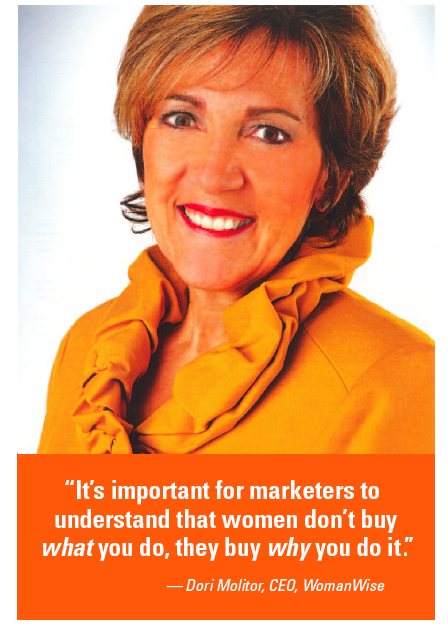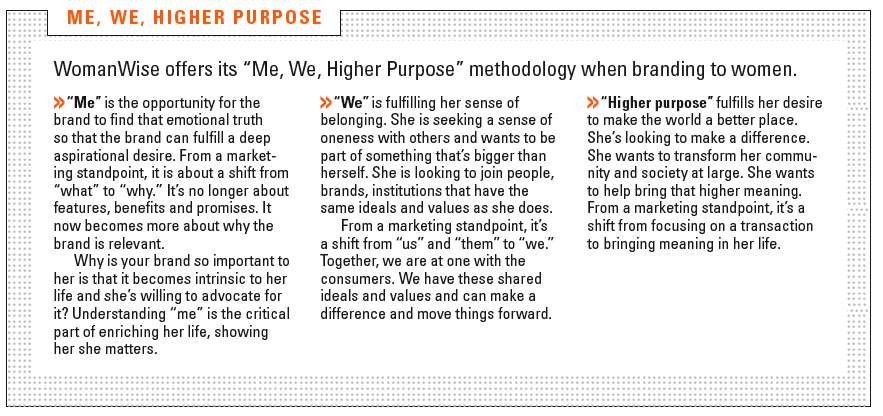 We’ve all seen the innovative advertisements touting the rejuvenating effects of skincare products or the must-have wardrobe accoutrements for the summer. Teeming with well-designed graphics, interesting content and engaging voice-overs, these streamlined visual masterpieces attract targeted audiences—namely women—and keep them coming back for more. Dori Molitor, CEO of WomanWise, a consulting firm specializing in marketing brands to women, shares her insights about marketing to this ever-evolving consumer base: women.
We’ve all seen the innovative advertisements touting the rejuvenating effects of skincare products or the must-have wardrobe accoutrements for the summer. Teeming with well-designed graphics, interesting content and engaging voice-overs, these streamlined visual masterpieces attract targeted audiences—namely women—and keep them coming back for more. Dori Molitor, CEO of WomanWise, a consulting firm specializing in marketing brands to women, shares her insights about marketing to this ever-evolving consumer base: women.
Q: Why is it important for people and companies to understand what it means to market to women? Why focus on women specifically, and what impact do women have on today’s brands?
Dori Molitor: The biggest challenge for marketers today is women’s indifference to their brands. There is growing irrelevance of perceived parity products and undifferentiated brands. There no longer is information overload because she has basically just stopped listening.
Most marketers say that they’re targeting women and recognize that women are the chief purchasing officer for the household, and yet there is this huge gap. She is buying 93 percent of everything, and yet, 85 percent of women will say that they do not feel understood by marketers.
Add to that the economic downturn. Harris published a survey finding that 63 percent of people feel that they are savvier since the financial crisis. If you look at those who rated themselves as savvier, nearly 70 percent feel marketers haven’t adjusted their marketing to keep pace.
An insufficient understanding of women is the fundamental reason for marketing failure today. We’re solving for that, in part, by specializing in insight mining and using that knowledge to develop and shape businesses.
Q: Can you tell me about the founding of WomanWise? Why is this consulting firm important to businesses of all types?
DM: Twenty-four years ago, when I started the company, we were all about integrated marketing and helping brands to have that one, single voice. All of that changed about 14 years ago, when I was working on a rebranding assignment for SnackWells cookies. During that assignment, I had a transformational moment that forever changed my business and my life.
We were doing ethnographic research in people’s homes, and I saw first-hand the passion and emotional connection that women had with this silly box of cookies. They were actually hoarding and hiding these cookies behind cereal and pasta boxes to keep them away from their children and their husbands.
We recognized this change in the world, with women having more authority and decision-making power in the workplace and yet nothing had changed at home. She was struggling in her efforts to redefine priorities—and it really came down to this box of cookies being a first step of permission to do something for herself.
Based on this insight, we recommended that SnackWells become the brand that would act on behalf of women of all ages. This revolutionary platform for the late-’90s led to an integrated strategy that supported women and girls through a series of intellectual, physical and spiritual initiatives.
For the first time in the business world, I felt as purposeful and energized as I did during my earlier years working as a legislative assistant in Congress. My efforts were positively impacting women’s and girls’ lives, and the brand was seeing double-digit growth.
Q: How has marketing to women changed over the years?
DM: Marketers have pretty much always recognized that women are the primary purchasers of the household. It’s only in recent years, however, that they have come to realize that it’s her subconscious emotional drivers that determine why she buys what she buys. In fact, cognitive scientists estimate that between 85 percent and 97 percent of the work the brain does is unconscious.
To be successful at meeting women’s needs it’s important to dig deeper to uncover the cultural, sociological, psychological and gender factors that drive their behavior. At WomanWise we’ve spent nearly two decades inventing and re-inventing projective insight tools that allow us to uncover their subconscious motivators to behavior.
Q: You conducted a study called the “American Dream” in 2011. Tell us more about this study and what you learned.
DM: In a 2011 study by Xavier University, 55 percent of Americans said they have lost trust and confidence in our country. Yet, 63 percent of Americans are extremely confident, or fairly confident in their ability to reach the American Dream. We wanted to understand, “Why the contradiction?”
Our multi-generational study of 800 women across the U.S. revealed that the dream has not gone away, but it has changed. As we struggle with global conflict, economic uncertainty and bloated personal debt, what really matters has changed. The ideals women are advocating today really go back to our founding fathers’ original vision— the pursuit of happiness. Her need for independence, equality, humanity, putting family and community first, freedom to choose, making a difference and paving her own destiny, all circle back to what the people who first came to this country were seeking—the dream of a better, richer, and happier life for all.
And it doesn’t equate to an endless AmEx credit line or a McMansion at the end of the block.
This shift in values and perspective creates a rare opportunity for business to fundamentally change how women feel about their brands. It’s an opportunity to demonstrate that she matters and to take the consumer/brand relationship to a higher, purpose-driven level. To get there requires an understanding of her craving for “me, we and higher purpose.”
Q: What are some common mistakes you see companies make when attempting to market to women?
DM: The biggest mistake I see is that marketers often assume marketing to women means painting the brand “pink,” as recently evidenced by the launch of “Chick Beer” and Dell’s “Della” computer line.
It is important to understand that women want everything men want—she just wants more! She’s more detailed-oriented, cares more about more things, considers a company’s ethical business practices when making a purchase, and holds businesses to a higher standard when it comes to doing social good.
Bottom line, if you meet women’s expectations, you’ll exceed men’s.
Q: Why did you enter this area of marketing to women?
DM: When I made the strategic shift to focus on marketing to women, my whole business – my life – moved to a higher purpose. Marketing to women is my profession, my passion and my cause.
I have found a platform to integrate my business expertise and my personal passions. Through our efforts, women’s unmet needs, desires, concerns, fears and emotional triggers are more deeply understood by business and marketing leaders. We bring “her voice” to the business strategic decision-making table. In the end, our clients have a competitive advantage because they have more meaningful relationships and relevance in women’s lives.
Q: What are some key things you’ve learned about women, and the way they think and how that impacts their purchasing decisions?
DM: What drives women’s ideals and purchase behavior evolves as the world around us changes. Today we’re living in conflicted and uncertain times, and confidence in institutions is at an all-time low. Women are moving forward in a new era of responsibility. She expects business to be a force for good in society, not just an engine for profit. They expect the same of themselves. She’s seeking ways to make a difference and to bring more meaning in her life. It’s a principle we call, “me, we, higher purpose.”
Q: If you could provide one piece of advice about marketing to women, what would it be?
DM: It’s important for marketers to understand that women don’t buy what you do, they buy why you do it. That’s where we can help business leaders get to the higher level of answering that question of why and bringing that more relevant engagement and connection with women.









